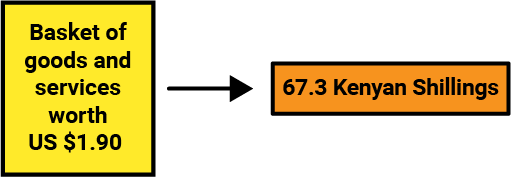Prices of goods and services differ across countries. For example, travelers often find that the price of a product abroad can be very different from the same product back home, when using market currency exchange rate to make comparisons. Typically, prices are lower in poorer countries and higher in richer ones. This is known as the Penn effect, and is why it often is cheaper to buy things in a relatively poorer country than a relatively richer one.
When comparing incomes across the world we often want to adjust for such price differences. To compare living standards, we want to know how much an income can buy in terms of goods and services locally. Due to price differences across countries, comparing incomes using market currency exchange can give us an inaccurate picture. Instead, we use purchasing power parity (PPP) exchange rates, which adjust for the different costs of buying a similar basket of goods and services in each country.
What are PPPs?
Put simply, PPPs help measure the total amount of goods and services that a single unit of a country's currency can buy in another country. PPPs are calculated by collecting and analyzing data on the prices of the same goods and services across many economies, and measure what the price of one good in one country is relative to another. Therefore, PPPs can be used to convert the cost of a basket of goods and services into a common currency called "international dollars".
The International Comparison Program (ICP) estimates PPPs based on a massive price collection exercise, involving a huge "basket" of many comparable goods and services collected in over 175 economies. This effort helps consumers, policy makers, and analysts, learn the relative purchasing power of various currencies in various countries. These purchasing power parities exchange rate are applied to many types of data in the WDI and elsewhere, and we illustrate their importance below:
Are all people living under $1.90 a day considered extremely poor?
The World Bank measures global poverty using an international poverty line set at $1.90 a day. But converted to local currencies at market exchange rates, $1.90 can buy very different amounts of goods and services depending on where in the world they are spent. Thus, to ensure that the poverty line represents same level of material well-being (or deprivation) across all countries of the world, PPPs are used.
For example, at market exchange rates, $1.90 converts to approximately 169 Kenyan Shillings in 2011. However, the PPPs for private consumption tell us that in Kenya, 169 Kenyan shillings can buy the equivalent of what $4.8 USD could buy in the United States. In terms of goods and services, $1.9 is worth more in Kenya than in the United States. Thus, the PPP exchange rate of 35.4 (instead of the market exchange rate of 88.8) is used when converting the poverty line into Kenyan Shillings to ensure that the poverty line means approximately the same in terms of the goods and services it can buy.

Source: World Development Indicators (PA.NUS.FCRF)

Source: World Development Indicators (PA.NUS.PPP)
Which is the largest economy in the world? … It depends!
The United States is the biggest economy in the world if we compare Gross Domestic Product (GDP) at market exchange rates. The United States is followed by China, Japan, and India. However, if we make the comparisons using purchasing power parities, these rankings do not hold. At PPPs, China's economy in 2017 was 25 percent bigger than United States', and surpassed the United States to be the largest economy in 2013. India's economy surpassed that of Japan in 2009. The change effect of adjusting for the priced differences can be seen by comparing the solid lines and the dotted lines in the figure below.
Which country in Latin America and Caribbean spends the most on health?
The PPP adjustments also allow us to compare health spending across different countries. In US dollars, The Bahamas spent approximately $1685 per person in 2015, the largest amount on health in Latin America and the Caribbean, and Trinidad and Tobago spent $1150. However, if we adjust for cost of living, we find that Trinidad and Tobago effectively spent more on health per person than The Bahamas, since goods and services are cheaper in Trinidad and Tobago. They spent over $2200 per person on health care in 2015, while The Bahamas spent nearly the same, $1700 per person.
How are PPPs used in the WDI?
These examples illustrate how International Comparison Program helps to draw many meaningful comparisons of economic data. The WDI adjusts several data series with the help of ICP for data topics not limited to poverty and GDP, but extending also to health and education spending, and energy use, among others.
While these comparisons are relatively easy to make with that data at hand, the calculations behind the PPP measure are often complicated. Defining which goods and services to include in the calculations and to find comparable items across all economies is itself a complicated undertaking. In addition to this, the data collection process is decentralized causing large variation in data quality.
However, the data has been improving over time, and thus enabling us to make better comparisons. Each new edition of the ICP aims to improve the methodology used, allowing for better comparisons. The most recent PPP conversion factors are based on prices collected in 2011 and extrapolated for subsequent years using domestic Consumer Price Indices. A new round based on 2017 prices are forthcoming.